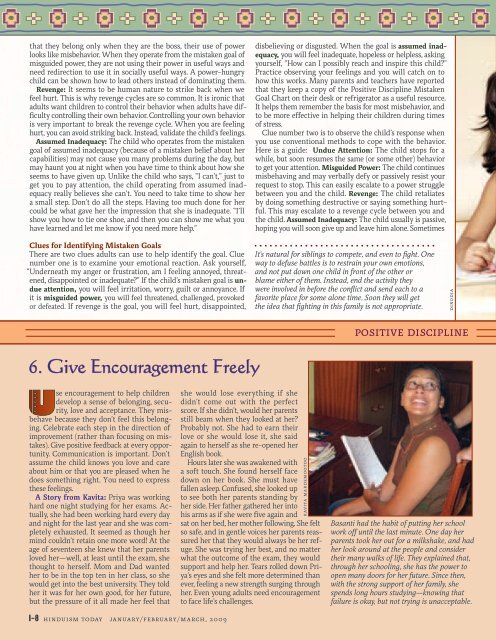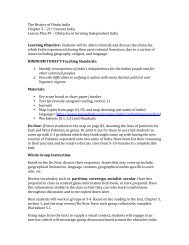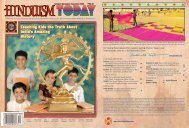Hinduism Today January 2009 - Cover, Index, Front Articles
Hinduism Today January 2009 - Cover, Index, Front Articles
Hinduism Today January 2009 - Cover, Index, Front Articles
Create successful ePaper yourself
Turn your PDF publications into a flip-book with our unique Google optimized e-Paper software.
that they belong only when they are the boss, their use of powerlooks like misbehavior. When they operate from the mistaken goal ofmisguided power, they are not using their power in useful ways andneed redirection to use it in socially useful ways. A power-hungrychild can be shown how to lead others instead of dominating them.Revenge: It seems to be human nature to strike back when wefeel hurt. This is why revenge cycles are so common. It is ironic thatadults want children to control their behavior when adults have difficultycontrolling their own behavior. Controlling your own behavioris very important to break the revenge cycle. When you are feelinghurt, you can avoid striking back. Instead, validate the child’s feelings.Assumed Inadequacy: The child who operates from the mistakengoal of assumed inadequacy (because of a mistaken belief about hercapabilities) may not cause you many problems during the day, butmay haunt you at night when you have time to think about how sheseems to have given up. Unlike the child who says, “I can’t,” just toget you to pay attention, the child operating from assumed inadequacyreally believes she can’t. You need to take time to show hera small step. Don’t do all the steps. Having too much done for hercould be what gave her the impression that she is inadequate. “I’llshow you how to tie one shoe, and then you can show me what youhave learned and let me know if you need more help.”Clues for Identifying Mistaken GoalsThere are two clues adults can use to help identify the goal. Cluenumber one is to examine your emotional reaction. Ask yourself,“Underneath my anger or frustration, am I feeling annoyed, threatened,disappointed or inadequate?” If the child’s mistaken goal is undueattention, you will feel irritation, worry, guilt or annoyance. Ifit is misguided power, you will feel threatened, challenged, provokedor defeated. If revenge is the goal, you will feel hurt, disappointed,disbelieving or disgusted. When the goal is assumed inadequacy,you will feel inadequate, hopeless or helpless, askingyourself, “How can I possibly reach and inspire this child?”Practice observing your feelings and you will catch on tohow this works. Many parents and teachers have reportedthat they keep a copy of the Positive Discipline MistakenGoal Chart on their desk or refrigerator as a useful resource.It helps them remember the basis for most misbehavior, andto be more effective in helping their children during timesof stress.Clue number two is to observe the child’s response whenyou use conventional methods to cope with the behavior.Here is a guide: Undue Attention: The child stops for awhile, but soon resumes the same (or some other) behaviorto get your attention. Misguided Power: The child continuesmisbehaving and may verbally defy or passively resist yourrequest to stop. This can easily escalate to a power strugglebetween you and the child. Revenge: The child retaliatesby doing something destructive or saying something hurtful.This may escalate to a revenge cycle between you andthe child. Assumed Inadequacy: The child usually is passive,hoping you will soon give up and leave him alone. SometimesIt’s natural for siblings to compete, and even to fight. Oneway to defuse battles is to restrain your own emotions,and not put down one child in front of the other orblame either of them. Instead, end the activity theywere involved in before the conflict and send each to afavorite place for some alone time. Soon they will getthe idea that fighting in this family is not appropriate.dinodiathis child will act out (such as being the classclown to cover up feelings of inadequacy inacademics, sports, etc.).These two clues help parents and teachersbreak the code of what children are really sayingwith their behavior. Even when we understandthe motive, it may not be easy to respondwisely. When we encounter a child who ismisbehaving, it is much easier (and normal)to react from our secondary feelings of angerand frustration than it is to stop and wonder:“What is this child trying to tell me?” In mybook, we also explain a technique of askingstrategic questions of the child to determinethe hidden motives of her behavior. One furthercomplexity is that a child may be motivatedby more than one mistaken goal at time!Effective InterventionOnce you know the mistaken goal (and the beliefbehind it), you can choose an effective strategyto create a connection with children andhelp them achieve their true goal of belongingand significance. Here are some basic remedies.when the goal is Undue Attention1) Redirect the child into contributing behavior.2) Do the unexpected. A big hug is ofteneffective. 3) Set up a schedule for special timewith the child on a regular basis. 4) Smile ina knowing way that communicates you arepositive discipline14 strategies parents need to know6. Give Encouragement Freely 7. Establish Routine ChartsUse encouragement to help childrendevelop a sense of belonging, security,love and acceptance. They misbehavebecause they don’t feel this belonging.Celebrate each step in the direction ofimprovement (rather than focusing on mistakes).Give positive feedback at every opportunity.Communication is important. Don’tassume the child knows you love and careabout him or that you are pleased when hedoes something right. You need to expressthese feelings.A Story from Kavita: Priya was workinghard one night studying for her exams. Actually,she had been working hard every dayand night for the last year and she was completelyexhausted. It seemed as though hermind couldn’t retain one more word! At theage of seventeen she knew that her parentsloved her—well, at least until the exam, shethought to herself. Mom and Dad wantedher to be in the top ten in her class, so shewould get into the best university. They toldher it was for her own good, for her future,but the pressure of it all made her feel thatshe would lose everything if shedidn’t come out with the perfectscore. If she didn’t, would her parentsstill beam when they looked at her?Probably not. She had to earn theirlove or she would lose it, she saidagain to herself as she re-opened herEnglish book.Hours later she was awakened witha soft touch. She found herself facedown on her book. She must havefallen asleep. Confused, she looked upto see both her parents standing byher side. Her father gathered her intohis arms as if she were five again andsat on her bed, her mother following. She feltso safe, and in gentle voices her parents reassuredher that they would always be her refuge.She was trying her best, and no matterwhat the outcome of the exam, they wouldsupport and help her. Tears rolled down Priya’seyes and she felt more determined thanever, feeling a new strength surging throughher. Even young adults need encouragementto face life’s challenges.kavita mardemootooBasanti had the habit of putting her schoolwork off until the last minute. One day herparents took her out for a milkshake, and hadher look around at the people and considertheir many walks of life. They explained that,through her schooling, she has the power toopen many doors for her future. Since then,with the strong support of her family, shespends long hours studying—knowing thatfailure is okay, but not trying is unacceptable.The more children do for themselves,the more capable and encouraged theyfeel. One of the best ways to avoidbedtime hassles and morning hassles is toget children involved in creating routinecharts. Start by having your child make a listof all the things she needs to do before goingto bed. The list might include: pick up toys,snack, bath, jammies, brush teeth, chooseclothes for the next morning, bedtime storyand hugs. Copy (or when children are oldenough let them copy) all the items onto achart. Then hang the chart on a wall whereshe can reach it. Let the routine chart be theboss. Instead of telling your child what to do,ask, “What is next on your routine chart?”Often, she will tell you without your asking.Remember, the goal is to help children feelcapable and encouraged. A nice fringe benefitis that you will be able to stop naggingand will experience more peaceful bedtimesand mornings.A Story from Kavita: Aruna, an onlychild, was always around grown-ups, so shethought she was all grown up, too. When itwas time to get ready for bed, she always insistedon staying up like Mom and Dad. Thesix-year-old would hold on to the sofa andscream until she got her way. As a result, shehad difficulty waking up in the morning forschool and sometimes even fell asleep at herdesk. All this left her moody and irritable.One day Mom read about routine charts,and their wonderful potential to make childrenhappier and healthier. When Arunacame home from school the next day, Momhad big white paper with color pens, glitterand cut outs all over the kitchen table. Ofcourse, Aruna wanted to help! Before long, toher own amazement, she had created a funlookingbedtime chart! She couldn’t wait tostart putting the gold stars in the squares.Mom told her that when the small handon the clock reached the 8, she could startfollowing the chart. It was so much fun thatshe actually looked forward to getting readyfor bed. By the time the newness wore outand she was no longer impressed by thechart, she had developed a strong routineand bedtime was no longer a hassle.Like Aruna in the story, Jayendra loves hisroutine chart. Completing it each day makeshim feel competent and independent.I-8 hinduism today january/february/march, <strong>2009</strong> january/february/march, <strong>2009</strong> hinduism today I-9kavita mardemootoo
















